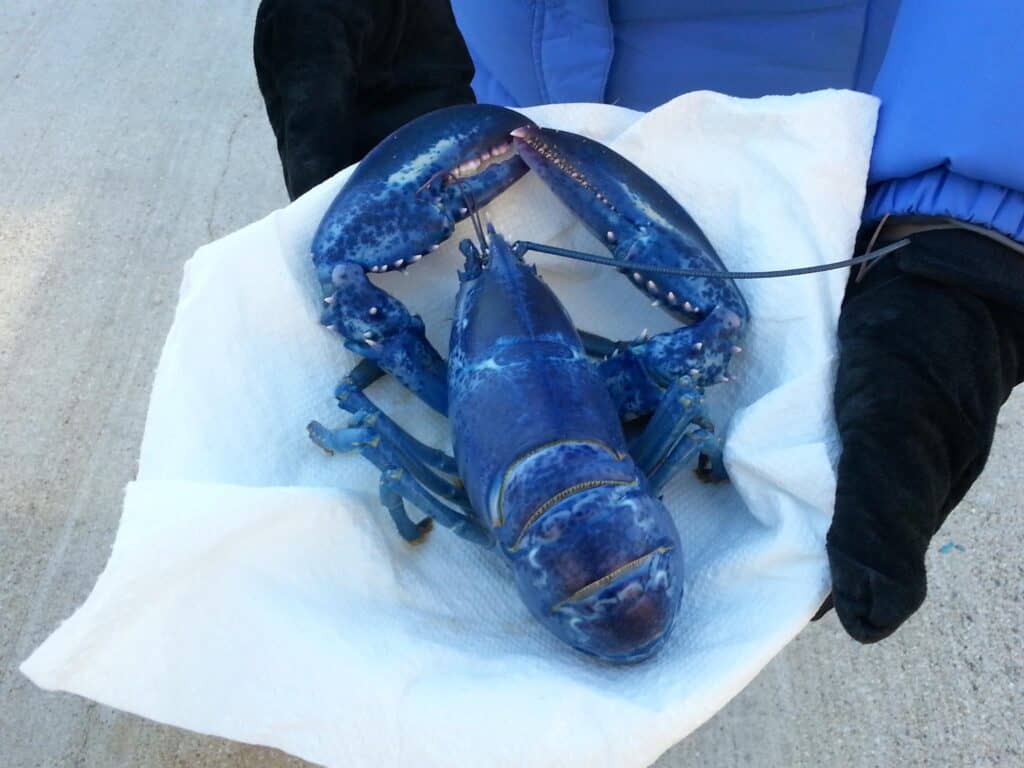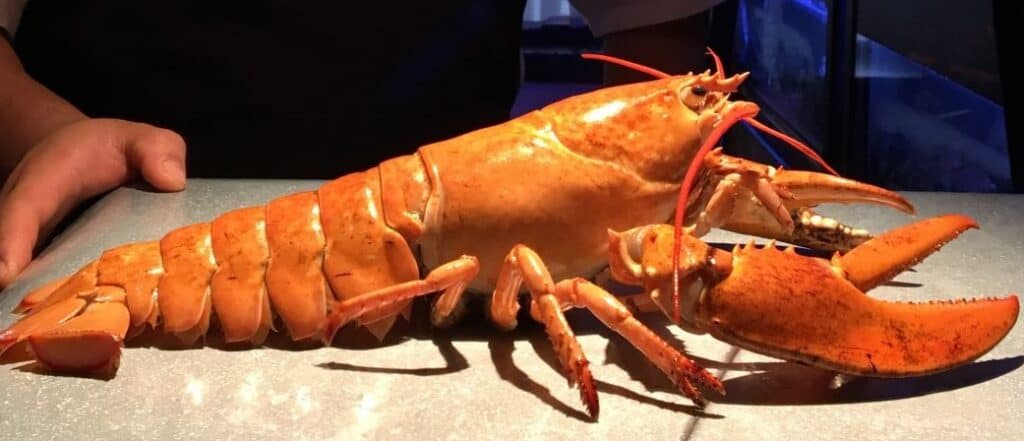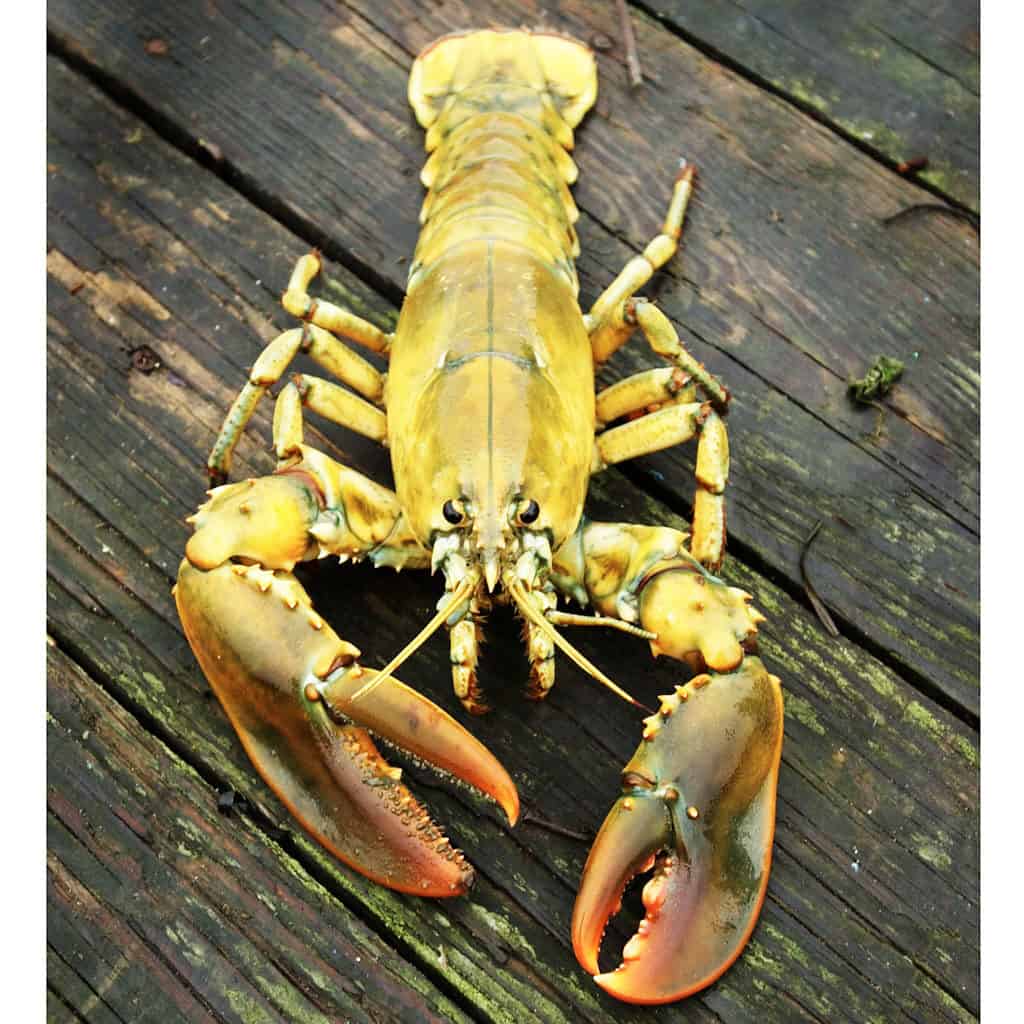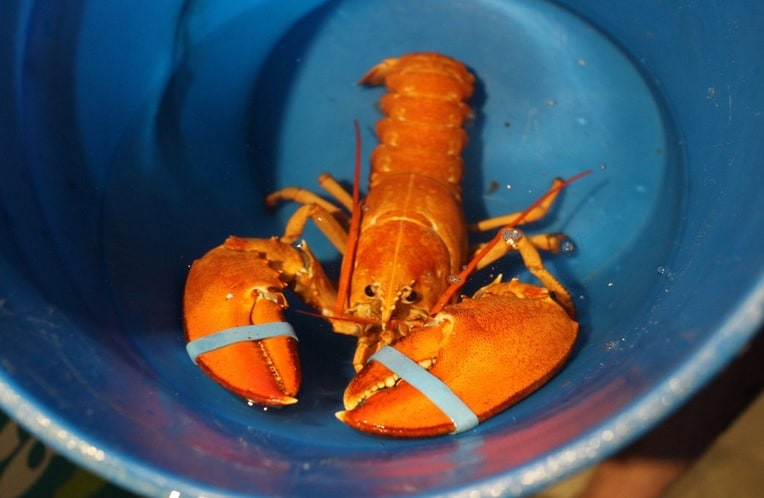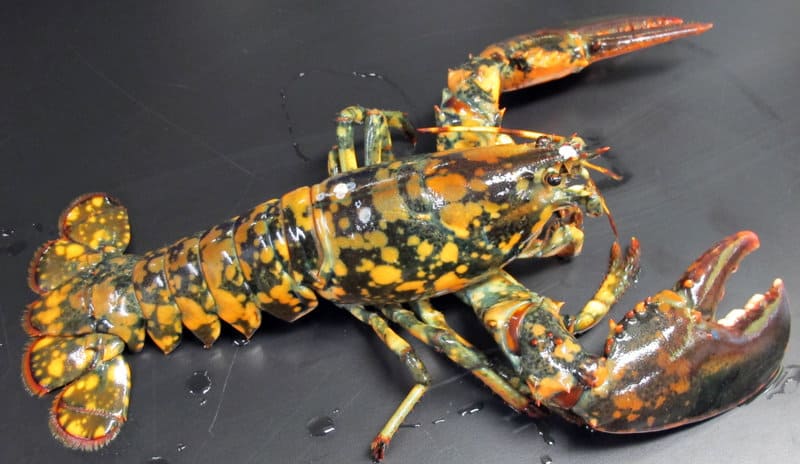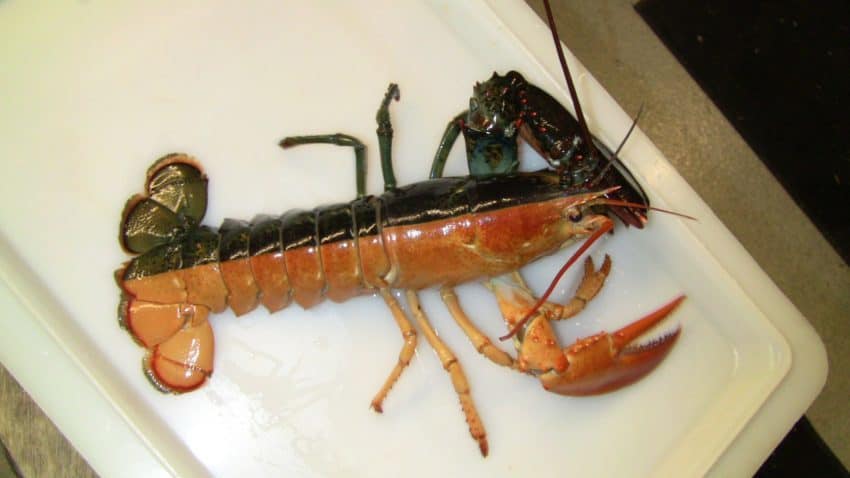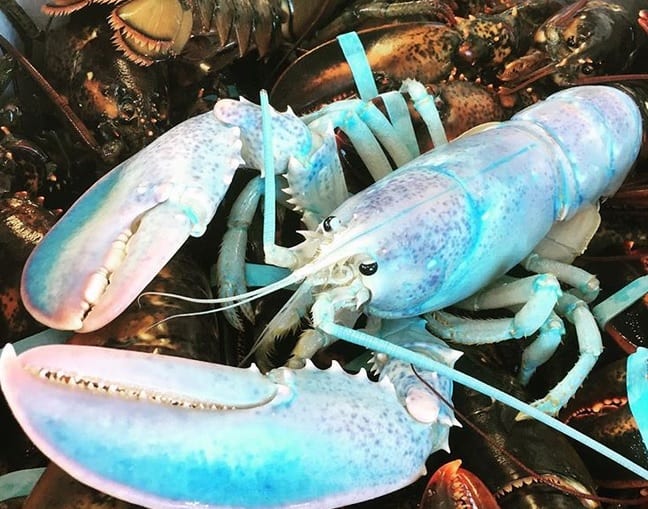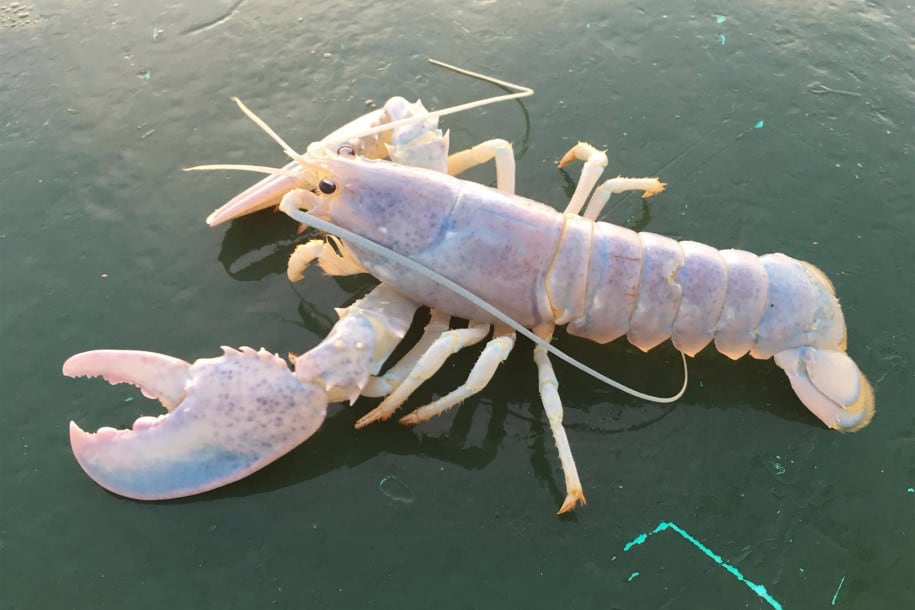Despite popular misconception, lobsters are not bright red while they’re alive (although natural red lobsters do exist, they’re more muted). Lobsters, regardless or their color when alive, turn red when they’re cooked. This is because the astaxanthin (a pigment protein) in their shells turns red after its exposed to heat.
While lobsters are typically a muddy brownish green color, they can appear in a wide variety of shades and patterns. These colors are rare because they increase a lobster’s vulnerability to predators in the wild. This list contains all of the known color variations, which range in rarity.
- Blue Lobster
- Red Lobster
- Yellow Lobster
- Orange Lobster
- Calico Lobster
- Split-Colored Lobster
- Cotton Candy (Pastel)
- White (Albino) Lobster
Notable Specimens: Lord Stanley
Most Recently Found In: Massachusetts in 2019

photo source: Wikimedia Commons via Sschemel
Blue lobsters are often newsworthy because of how beautiful and different their coloring is. However, of all the rare lobster colors, blue lobsters are the most common, occurring about once in every two million lobsters. Blue lobsters are common enough that lobsterman in Maine find blue lobsters every year or two.
The bright blue coloring is caused by a genetic mutation that produces an overabundance of astaxanthin-wrapping proteins. These proteins turn all the red astaxanthin into blue crustacyanin.
Did you know?
The fisherman in the Nova Scotia, Canada region believe that catching a blue lobster is a sign of good luck.
Notable Specimens: Ruby
Most Recently Found In: Caught in Massachusetts, but found in New York City restaurant in 2016

photo source: Fox News via Rob Verger
It’s probably pretty common for people to believe that lobsters are bright red, but this only happens after they’re cooked. However, there is a one in ten million chance that a live lobster will be naturally red.
A rare red lobster popped up at the Burger & Lobster restaurant in New York City and was dubbed Ruby. According to executive chef Danny Lee, Ruby look like she had been cooked, but was very much alive. The restaurant donated Ruby to the Long Island Aquarium and Exhibition Center in Riverhead, New York.
Did you know?
Naturally red lobsters can turn even redder if fed a diet of crabs, crab shells, and shrimp.
Notable Specimens: Pale yellow lobster donated to New England Aquarium and Ruby
Most Recently Found In: Massachusetts in 2017; Nova Scotia in 2017
photo source: Food & Wine via Jack Milton of the Portland Press Herald
While yellow lobsters only appear once in every thirty million, two yellow lobsters were found in 2017. One of the lobsters was caught in Massachusetts by lobsterman Bill Porter and donated to the New England Aquarium. The other yellow lobster was caught in Nova Scotia and made it all the way to a Manhattan restaurant before anyone noticed. The restaurant decided not to cook the yellow lobster, named her Ruby, and put her on display in her own tank.
Similar to orange lobsters, yellow lobsters lack the proper proteins to produce normal coloration.
Did you know?
The yellow lobster donated to the New England Aquarium joined a multicolored lobster exhibit that contains unusually colored lobsters including blue, orange, split-colored, and more.
Notable Specimens: Bright orange lobster found in supermarket
Most Recently Found In: Cape Breton Island, Nova Scotia, Canada in 2018

photo source: New England Aquarium
In 2018, a grocery store in Westborough, Massachusetts discovered a bright orange lobster along with its drabber siblings in a shipment from Nova Scotia, Canada. The orange lobster was donated to the New England Aquarium, who says that the orange coloring only occurs once in every 30 million lobsters. The New England Aquarium believes that this particular orange lobster is between seven to nine years old, which is amazing because the bright orange makes the lobster easily visible to predators.
Did you know?
According to scientists, orange lobsters lack the protein that make them the traditional muddy brown color, so they show more carotenoid pigment instead.
Notable Specimens: Eve, Friendly Kreuger, and Calvin
Most Recently Found In: Caught in Maine, but discovered at Maryland seafood market in 2018

photo source: NPR via Tony LaCasse of New England Aquarium
Calico lobsters, which have a mottled black and orange shell, are some of the most unique lobsters out there. According to the University of Maine’s Lobster Institute, finding a calico lobster is a 1 in 30 million chance.
Surprisingly, calico lobsters are necessarily noticed by lobstermen (probably because of their darker color) when they’re captured. Instead, calico lobsters have become famous for being spared from the dinner plate after being noticed by restaurant staff or seafood market employees. Luckily, these calico lobsters were donated to research aquariums.
Did you know?
The Biomes Marine Biology Center in Rhode Island reported that an unusually high number of calico lobsters were discovered in 2009 and the aquarium has been gifted several calico lobsters in recent years.
Notable Specimens: Pinchy the “Halloween” Lobster
Most Recently Found In: Maine in 2019

photo source: boston.com
Split-colored lobsters can come in any color combination, but one of the most striking and common is the “Halloween” variety. As their name implies, Halloween lobsters are half black or dark brown (a lobster’s normal color) and half orange. The split-coloring is most likely due to a complete cellular division when the lobster egg is first fertilized.
Scientists think that split-colored lobsters occur once in every 50 to 100 million lobsters, making them nearly as rare as white lobsters. Over the last few decades, split-colored lobsters have been found in the waters of Maine, Rhode Island, Nova Scotia, and Prince Edward Island.
Did you know?
Almost all split-colored lobsters are hermaphroditic, which means it has both male and female sexual characteristics.
Notable Specimens: Lucky
Most Recently Found In: Casco Bay, Oregon, USA in 2019

photo source: Instagram via Robinson Russell
The cotton candy or pastel lobster is believed to be about as rare as the white lobster. Scientists also think that the unique pink and blue coloring under a translucent shell may just be a sub-type of an albino lobster.
Like white lobsters, cotton candy lobsters appear every few years and one fisherman even caught the same cotton candy lobster twice in Casco Bay, Oregon in 2019. The first time he caught the cotton candy lobster it was too small to keep and after the second time he decided to keep it until he could donate the lobster to an aquarium.
Did you know?
One of the first times that a cotton candy lobster made headlines was in 2018 when fisherman Robinson Russell donated “Lucky” to the Huntsman Marine Science Centre in New Brunswick. Lucky’s story went viral and was even covered by National Geographic.
Notable Specimens: White lobster donated to Oceanworld Aquarium in Dingle, Ireland for breeding program
Most Recently Found In: Mizen Head, West Cork, Ireland and Stonington, Maine, USA in 2018

photo source: New York Post via Mike Billings
White lobsters – also known as translucent, ghost, and crystal lobsters because of their pale coloring – are the rarest lobsters in the world. With an occurrence of only 1 in 100 million lobsters, ones with white coloring only pop up a few times every four or five years.
Typically white lobsters come about due to albinism, other genetic mutations, or an unusual diet. In 2018, an Irish fisherman donated the female white lobster he found to Oceanworld Aquariurm in Dingle, Ireland to start a breeding program.
Did you know?
Michael Tlusty, associate professor of sustainability and food solutions at the University of Massachusetts Boston, accidentally created white lobsters when he fed them a cheaper food alternative that lacked the necessary pigment for normal coloring.

